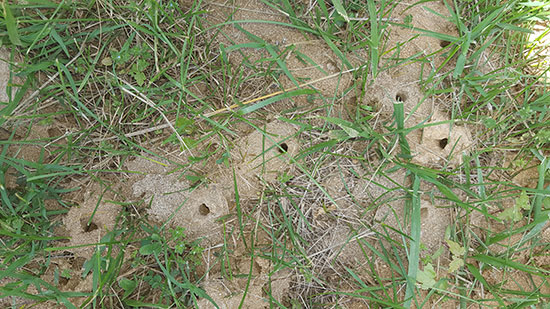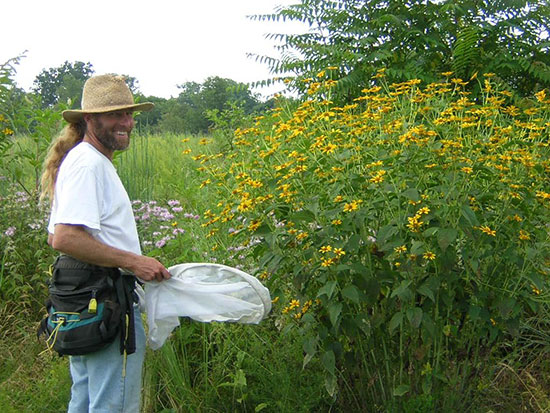Get Friendly with Helpful, Not Hurtful, Ground Bees
They don’t live in a hive, don’t make honey, and won’t sting. Meet the insects helping to pollinate our crops from the ground up.
Get Friendly with Helpful, Not Hurtful, Ground Bees
They don’t live in a hive, don’t make honey, and won’t sting. Meet the insects helping to pollinate our crops from the ground up.

Each spring many people across the US become alarmed when ground bees emerge from small holes in lawns and gardens in late spring and early summer.
Although their tendency to hover over their nests might seem aggressive on first glance, experts say rather than reaching for insecticide, growers should be grateful. Those little native bees coming up from the soil aren’t likely to sting, and they’re excellent pollinators, especially for fruiting shrubs and trees.
First, an important clarification: Ground bees are not the same as yellow jackets, which are wasps that often make nests in the ground and impart a painful sting when disturbed. They’re also not honeybees, which were imported to the US from Europe several centuries ago. Honeybees make honey and are social insects who raise young together in a big hive. They can also sting.
Ground bees – a term that covers more than 70 percent of the 4,000-plus bee species native to North America – look a lot like European honeybees when seen in flight or on a flower, since they too have hairy, colorful, or black-striped bodies. But they don’t make honey. The males can’t sting, and the females are often very docile and don’t sting. And unlike both wasps and honeybees, native bees are solitary. One mom lays her own eggs and tends to her own nest in a tiny hole in the ground.
Yellow jacket nests and ground bee nests also look very different from each other. Whereas wasp nests have one central entrance hole an inch or more wide from which individual wasps frequently come and go, many ground bees come and go from tiny quarter-inch openings that look more like ant hills or teeny chimneys.
Ground bees of the genus Colletes, for example, find places where there is loose, open, poor soil, then dig holes and lay their eggs within inches of one another. But despite the dramatic numbers and the swirl of humming activity over the nests, there is nothing to fear. These bees have no queen or shared resource like honey to defend or protect.
“You can literally lie down in the middle of one of these native bee aggregations and you’re not going to be impacted,” says Sam Droege, a bee researcher with the US Geological Survey. “Nobody’s allergic to native bees,” he says.


Your trees and shrubs will be impacted positively, though, if these bees show up in your growing space; Colletes bees are “big-time pollinators” Droege says, especially of apples, berries, and other woody plants.
In fact, bees from the genus Andrena, a type of ground bee sometimes called a miner bee, are treasured in orchards, says T’ai Roulston, a biologist with the University of Virginia’s Blandy Experimental Farm.
Some studies have found that even when honeybees are brought into orchards, miner bees remain the more common and sometimes the more dominant pollinator for fruit trees. This is especially true for smaller orchards, although Roulston notes that as the as the size of the orchard increases, the honeybee is more likely to dominate and do more of the pollinating.
Miner bees are also often found to be more effective at depositing pollen in the flowers than honeybees, Roulston says, which can lead to more fruit.


You might also find native squash bees from either the Peponapis and Xenoglossa genus living a solitary life in your garden if you plant squash or pumpkin plants, Roulston adds. Female squash bees will only collect pollen from day-flowering gourds and squash species, making them the dominant pollinator for those plants. What’s more, squash bees will travel as far as a mile searching for their chosen pollen-providing host plants, and then the females will nest on the ground right underneath of them.
“[Squash bees] are quite charismatic. And the males sleep right in the flower as it closes up at night.”
“They are quite charismatic,” Roulston says of the squash bee species. “And the males sleep right in the flower as it closes up at night.”
Over the years, both experts say they’ve met a surprising number of people who want information on getting rid of these helpful bees.
Since the majority of native bees like to nest in open, uncovered soil you could try enriching it with compost to discourage them from returning next year. Beefing up your lawn will help to make them go away, as will covering the soil with mulch sometimes, Droege says.
But why not embrace the beauty and the benefits of the many harmless native bee species? Unlike honeybees, these pollinators don’t need any tending or special equipment. And the species that like to hover around over the ground are often only out for a few weeks each year.
Those who get them should feel lucky, Droege adds. “They are really fun to watch,” he says. “You can take a picture and put it up on Facebook and be a hero.” (And speaking of photos, don’t miss the USGS Bee Inventory and Monitoring Lab’s database of amazing bee photography. Droege takes each photo by attaching a low-resolution camera to a microscope, according to the Wall Street Journal.)
“Be curious about them rather than afraid,” says Roulston. “They are doing a service for you while asking very little in return.”
Follow us

This work is licensed under a Creative Commons Attribution-NoDerivatives 4.0 International License.
Want to republish a Modern Farmer story?
We are happy for Modern Farmer stories to be shared, and encourage you to republish our articles for your audience. When doing so, we ask that you follow these guidelines:
Please credit us and our writers
For the author byline, please use “Author Name, Modern Farmer.” At the top of our stories, if on the web, please include this text and link: “This story was originally published by Modern Farmer.”
Please make sure to include a link back to either our home page or the article URL.
At the bottom of the story, please include the following text:
“Modern Farmer is a nonprofit initiative dedicated to raising awareness and catalyzing action at the intersection of food, agriculture, and society. Read more at <link>Modern Farmer</link>.”
Use our widget
We’d like to be able to track our stories, so we ask that if you republish our content, you do so using our widget (located on the left hand side of the article). The HTML code has a built-in tracker that tells us the data and domain where the story was published, as well as view counts.
Check the image requirements
It’s your responsibility to confirm you're licensed to republish images in our articles. Some images, such as those from commercial providers, don't allow their images to be republished without permission or payment. Copyright terms are generally listed in the image caption and attribution. You are welcome to omit our images or substitute with your own. Charts and interactive graphics follow the same rules.
Don’t change too much. Or, ask us first.
Articles must be republished in their entirety. It’s okay to change references to time (“today” to “yesterday”) or location (“Iowa City, IA” to “here”). But please keep everything else the same.
If you feel strongly that a more material edit needs to be made, get in touch with us at [email protected]. We’re happy to discuss it with the original author, but we must have prior approval for changes before publication.
Special cases
Extracts. You may run the first few lines or paragraphs of the article and then say: “Read the full article at Modern Farmer” with a link back to the original article.
Quotes. You may quote authors provided you include a link back to the article URL.
Translations. These require writer approval. To inquire about translation of a Modern Farmer article, contact us at [email protected]
Signed consent / copyright release forms. These are not required, provided you are following these guidelines.
Print. Articles can be republished in print under these same rules, with the exception that you do not need to include the links.
Tag us
When sharing the story on social media, please tag us using the following: - Twitter (@ModFarm) - Facebook (@ModernFarmerMedia) - Instagram (@modfarm)
Use our content respectfully
Modern Farmer is a nonprofit and as such we share our content for free and in good faith in order to reach new audiences. Respectfully,
No selling ads against our stories. It’s okay to put our stories on pages with ads.
Don’t republish our material wholesale, or automatically; you need to select stories to be republished individually.
You have no rights to sell, license, syndicate, or otherwise represent yourself as the authorized owner of our material to any third parties. This means that you cannot actively publish or submit our work for syndication to third party platforms or apps like Apple News or Google News. We understand that publishers cannot fully control when certain third parties automatically summarize or crawl content from publishers’ own sites.
Keep in touch
We want to hear from you if you love Modern Farmer content, have a collaboration idea, or anything else to share. As a nonprofit outlet, we work in service of our community and are always open to comments, feedback, and ideas. Contact us at [email protected].by Alison Gillespie, Modern Farmer
June 17, 2016
Modern Farmer Weekly
Solutions Hub
Innovations, ideas and inspiration. Actionable solutions for a resilient food system.
ExploreExplore other topics
Share With Us
We want to hear from Modern Farmer readers who have thoughtful commentary, actionable solutions, or helpful ideas to share.
SubmitNecessary cookies are absolutely essential for the website to function properly. This category only includes cookies that ensures basic functionalities and security features of the website. These cookies do not store any personal information.
Any cookies that may not be particularly necessary for the website to function and are used specifically to collect user personal data via analytics, ads, other embedded contents are termed as non-necessary cookies.
Thank you for this article. I live in a condominium community and too many people are ignorant to the benefits of all bees. I’m a beekeeper and I’m always trying to educate people to the benefits of ground bees…they are harmless. All some people want is to call the exterminator and put pesticides down on the ground…it sickens me. So thank you again as I’ve used your article to help educate the board of directors and the condo management company.
Do these bees love water? We have some that we thought were honey bees but they love my pups little pool and hundreds of them at that. They don’t sting her or anything they just mind their own business. Just curious
Ok. I have tried to do research and landed here and hope someone can answer my questions. First I have about 5-6 ground bee subspecies in nests living in the area of our “swamp”. I saw that miner bees like sandy soils. Our is NOT sandy. Second they are NOT yellow jacket wasps. Third they sting. I have had two separate people get stung 5-6 times when planting native (Pa,Berks county) pollinator friendly plants. Or pulling weeds. I do NOT want to kill them, of course, but I would love to know what kind they are. Both my hubby and… Read more »
We had two nests in our backyard. My grandson was helping me and didn’t see there nest in the ground near where he was and was stung and then chased by them. The same thing happened to my gardener and was stung several times. I had no choice but to have them exterminated.
I have a nest but only one not several
Also they are not solitary.
They are very tiny less than a quarter of an inch long
With polen on their legs as they come and go.
I have a great colony of ground bees that I love. I leave their area of the garden undisturbed until they have completed their Spring cycle. My question is: can I dig/plant that area once they are completely gone or will that destroy the colony for next year?
Thank you! Very enlightening! You changed my perspective and I will no longer be in fear! God Bless!
I have had several nests in my yard for several years now but have never seen the bees go in or out but each spring they are opened back up again.
I have noticed several nest sites in our orchard that look like your photo of the Colletes entrance holes (see attached photo). My question is about the makeup of the granular stuff that makes up the hill. It is more yellow than the native soil – is that pollen mixed with the dirt?
If anyone wants some and you live in or near the Richmond area of Virginia I have a whole yard of them. I don’t want to use pesticides but they have reproduced to incredible numbers.